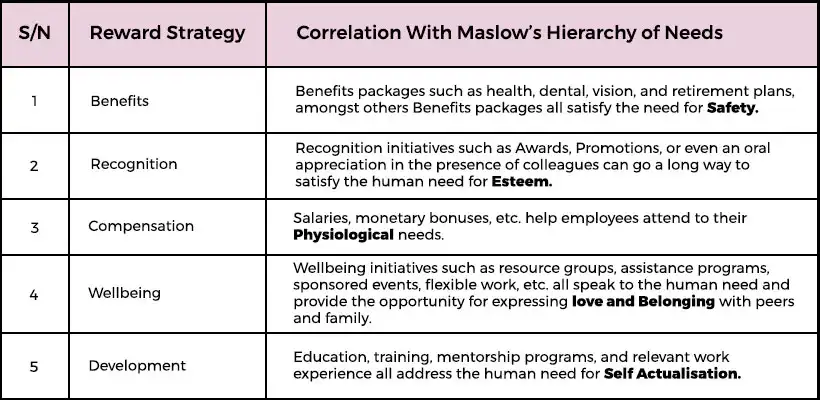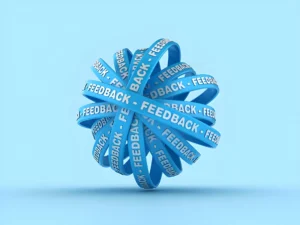Creating a total rewards strategy often signals an organisation’s drive to develop a workforce motivated toward excellence and growth.
This strategy is a system implemented by an organisation to provide benefits to staff who meet specific business targets. Such a strategy combines compensation and benefits with personal growth opportunities inside a motivating work environment.
A total rewards strategy is effective when it encourages employees to work more productively, stay with the company for longer, and attract new talent.
Top executive and management buy-in is critical for creating a total rewards strategy. To ensure C-Suite cooperation, your project team should be made up of decision-makers and front-line employees to guarantee that your approach is well-rounded and fits the needs of everyone at the table.
Often, the HR department or a compensation and benefits team within the organisation is responsible for executing an organisation’s total rewards strategy.
Essential Elements in Creating a Total Reward Strategy
For a total rewards strategy to be fully effective, it should satisfy the five fundamental human needs identified by Abraham Maslow.
These five needs, commonly dubbed “Maslow’s Hierarchy of Needs,” are as follows:
- Self Actualisation – This refers to the desire to be the best version of ourselves personally and professionally.
- Esteem – This describes the desire to have a high status or title, be recognized, be well respected, etc.
- Love & Belonging – This underlines our need for community and relationships. Examples include friendships, familial relationships, and so on.
- Safety – Stability is also a fundamental need. People desire to have secure jobs, work in a stable organisation, and have easy access to healthcare and education — all of which provide a sense of safety.
- Physiology – All human beings require basic needs such as food, water, shelter, and clothing.
So how can a total reward strategy tick all five fundamental needs? Here is how a Reward Strategy can satisfy these needs:
How a Reward Strategy Can Satisfy Maslow’s Hierarchy of Needs

Thus, a robust total reward strategy must be able to tick all boxes on Maslow’s hierarchy of Needs.
Creating a Total Reward Strategy
There are four processes to developing a total reward strategy. These are:
- Assessment
- Design
- Execution
- Evaluation
1. Assessment
A team assesses the current benefits and compensation system and determines the effectiveness of those systems in helping your company reach its goals.
Activities during the assessment phase include surveying your employees on their opinions and beliefs regarding their pay, benefits, and opportunities for growth and development and an examination of the current policies and practices in your organisation.
The most critical outcome of the assessment is the project team report, which includes recommendations for the new total rewards system.
The assessment report should include suggested solutions to questions such as:
- Who should be eligible for the rewards?
- What kinds of behaviours or values are to be rewarded?
- What type of rewards will work best?
- How will the company fund this?
2. Design
The senior management team identifies and analyzes various reward strategies to determine what would work best in their workplace. Then, it decides what will be rewarded and what rewards will be offered to employees for those achievements.
In a total rewards strategy, pay rewards for achieving goals will not be the only consideration.
HR strategists will also determine additional benefits (flexible work schedule, additional time off) or personal development opportunities (training or promotional) that employees will receive for meeting the established company objectives.
3. Execution
The HR department implements the new rewards system. In addition, it circulates materials that communicate the new strategy to employees.
Training also commences so that managers and decision-makers can effectively measure the strategy and employees can understand what they need to do to receive rewards.
4. Evaluation
The effectiveness of the new plan must be measured and the results communicated to company decision-makers. The HR or Benefits team can then propose modifications for future implementation.
3 Evaluation Metrics to Assess Performance of a Total Rewards Strategy
Here are examples of evaluation metrics that can be deployed to assess the performance levels of a total rewards strategy:
A. Employee Turnover: This refers to the percentage of employees who quit a company. This turnover rate can be measured at the company level and within departments, positions, managers, etc.
With this, you can:
- Determine the cost of employee attrition and determine whether it is detrimental.
- Measure employee retention.
- Develop a staffing plan, calculate costs and resources for recruitment, training etc.
- Identify weak points in employee performance management.
- Ascertain the real reasons why people leave their jobs and company.
B. Satisfaction Level: To define employees’ satisfaction with their job, it is better to ask them directly. The most popular subject for discussion is satisfaction with the compensation package.
Learn what employees think about their salaries, perks, and bonuses and whether their quality and level are good enough. But there are also more complex surveys.
C. Career Growth: This metric shows the possibility of promotion within the company, namely the vertical and horizontal career growth opportunities.
When done right, a total rewards strategy can attract and retain top talent and help your organisation outperform the competition.
However, payroll mistakes can severely hamper the effectiveness of your strategy. Are you having payroll concerns with respect to creating a total rewards strategy for your organisation? Then schedule a consultation today; let’s help you succeed.






